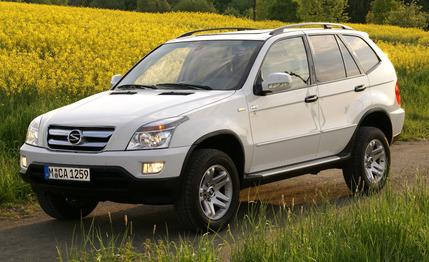 First Drive Review
First Drive Review
Many of today’s latest cars blend right into traffic. Boring, isn’t it? As automotive pundits, we cannot deny the appeal of driving cars that attract attention from other motorists. Pulling up to a stoplight in a Mini Cooper brings big, beaming smiles. Jaws go slack when we roar by in a bright-yellow Lamborghini Gallardo. And envy was a common reaction to the Bentley Continental GT that adorned our parking lot for a few days. We’d witnessed the full scale of emotional reactions to cars, we thought. But then we drove the Shuanghuan CEO and encountered yet another reaction: righteous indignation.
Who thought driving a 4000-pound SUV powered by a feeble four-cylinder could be so much fun?
If you are a mischievous sort, drive the CEO alongside a BMW X3 or X5 and glance over. In Germany, the gawking and looks of disbelief are priceless. Everyone in Germany has heard about it: This Chinese-built SUV was the talk of last year’s Frankfurt auto show as BMW tried to prove that the CEO is a plagiarized X5 in an attempt to ban it from European roads. But before that happens—and it may never happen—we have borrowed a CEO to see if the BMW-ness is more than skin deep.
To deny that the self-confidently named CEO was inspired by BMW’s X-model sport-utes would be fairly pointless. But the CEO is not identical to the X5 or the X3. Rather, the styling borrows elements of both. The greenhouse is X3-like, and the rear end is decidedly X5-ish. The CEO’s front-end styling is the greatest departure from the BMW SUVs (or SAVs, as BMW calls them). Altogether, the CEO is a curious but not entirely unattractive blend of generic Japanese and BMW styling. Shuanghuan tells us that upcoming versions of the CEO will be developed with styling that will not borrow from that of the Bavarians.
Step inside, and the CEO proves to have plenty of space for five lofty seating positions. The CEO comes with a decent amount of standard equipment and costs less than a base RAV4 in Germany. Options include leather seats, parking sensors, power seats, and a power sunroof. Just don’t have lofty expectations for the CEO’s fit and finish. Most modern SUVs use better materials and feel more uniformly screwed together than the CEO. Our test vehicle was prototype-like in some spots. The leather and faux aluminum touches make a favorable first impression and appear rich in photos, but a closer inspection proves less gratifying.
When behind the wheel of the CEO, it’s probably not a good idea to wave your pink slip challengingly at the guy beside you. The 123-hp Chinese 2.4-liter four-cylinder engine, basically an old Mitsubishi design, provides leisurely performance. The second-rate engine works well enough around town, provided you work the smooth-shifting, long-throw shifter enough to keep the CEO moving. But on highways or on the autobahn, the engine’s lack of power is glaring and immediately apparent. A 2.5-liter version of the engine with 165 horsepower is in the works, and a 195-horsepower turbo-diesel engine is also reportedly on the way.
The extra power will be welcome, but it won’t teach the CEO how to dance. Despite its modern looks, it’s really an old-school sport-ute based on a second-generation Mitsubishi Montero. Body roll is poorly controlled, and the steering requires constant corrections. On the other hand, the CEO can soldier on off-road where sportier SUVs likely would get stuck.
On European roads, the CEO is a massive vehicle, and for those who shop for cars by the pound, the CEO might just deliver some value. Shuanghuan is evaluating the U.S. market, and an American launch will become more likely when the dollar strengthens against the Chinese yuan. So, aside from its looks, the CEO is nothing like the BMWs it seeks to emulate. The CEO might be ready to do battle with other body-on-frame SUVs such as the Nissan Xterra and Ford Explorer. But neither an Xterra nor an Explorer would outrage your X5-driving neighbor in the same way a Chinese knockoff might.